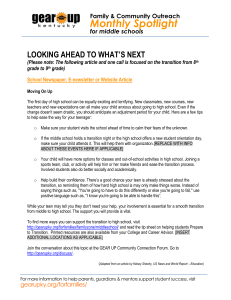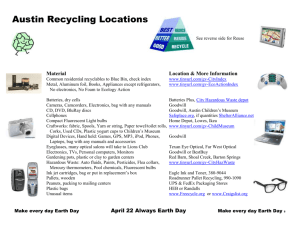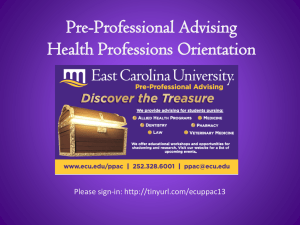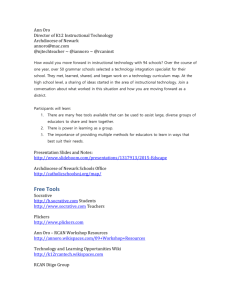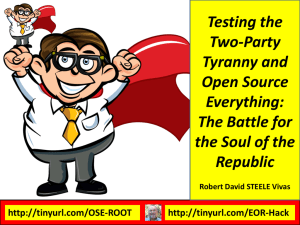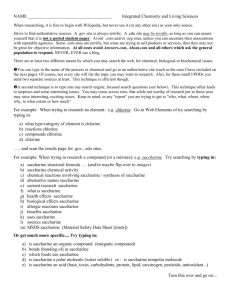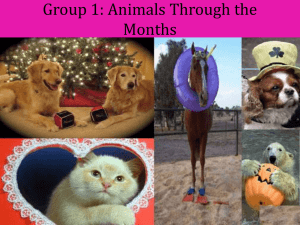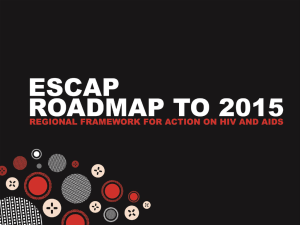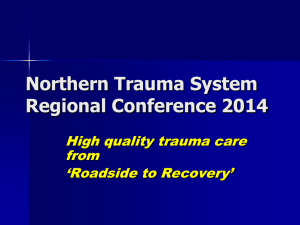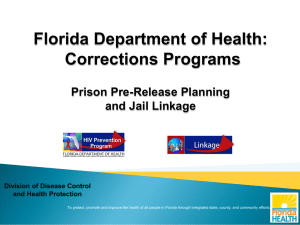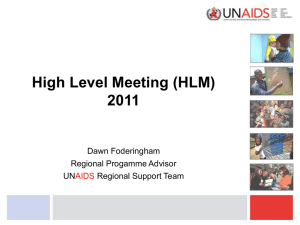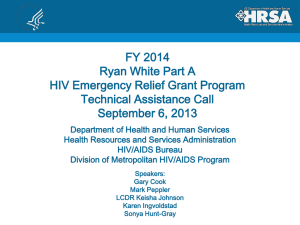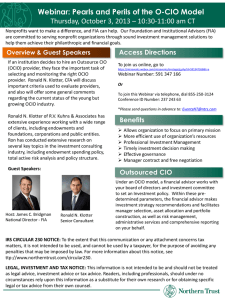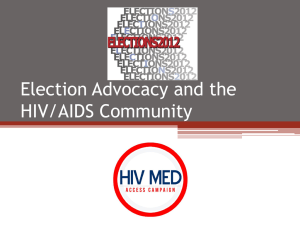Positive Women`s Network-USA Webinar
advertisement
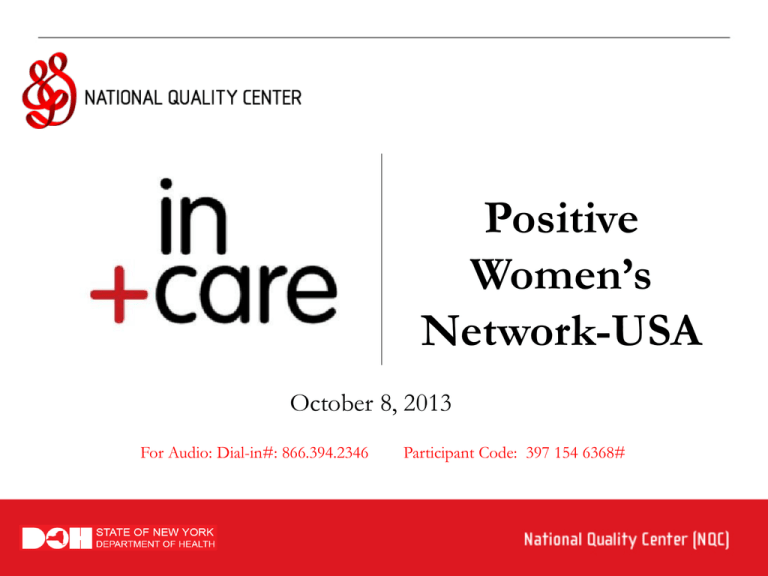
Positive Women’s Network-USA October 8, 2013 For Audio: Dial-in#: 866.394.2346 Participant Code: 397 154 6368# Agenda 1. 2. 3. 4. Welcome & Introductions, 5min PWN Explores Retention, 30min Panel Discussion, 20min Announcements, 5min Michael Hager in+care Campaign Manager National Quality Center New York, NY michael@nationalqualitycenter.org 2 In the chat room, Enter your: 1. name, 2. agency, 3. city/state, and 4. professional role at agency Welcome & Overview This Partners in+care webinar is offered as part of the in+care Campaign. The in+care Campaign is a national effort to improve retention in HIV care. Webinars are one of many Partners in+care activities designed to engage people living with HIV/AIDS and their allies in the in+care Campaign. For more information: www.incarecampaign.org 3 Participation Guidelines This is a “public event.” If you have confidentiality concerns: Your names appear on-line in the list of webinar registrants -consider just listening to the audio or to viewing the webinar at a later time, after it is posted at www.incarecampaign.org All webinars are recorded - do not use identifying information when asking questions For Audio: Dial-in#: 866.394.2346 4 Participant Code: 397 154 6368# Participation Guidelines Actively participate and write your questions into the chat area during the presentation; we will pause for conversation during the webinar Do not put us on hold Mute your line if you are not speaking (press *6, to unmute your line press #6) The slides and recording of this and other Partners in+care webinars are available for playback and group presentations at www.incarecampaign.org – “Resources” tab For Audio: Dial-in#: 866.394.2346 5 Participant Code: 397 154 6368# www.pwn-usa.org Engaging and Retaining Women Living with HIV In Care Naina Khanna Executive Director Positive Women’s Network – USA Partners InCare Webinar Oct 2013 www.pwn-usa.org fb: tinyurl.com/pwnusafacebook tw: @uspwn www.pwn-usa.org Overview 1. 2. The cascade for women Barriers and Challenges a. Structural b. Provider-Patient Interactions a. b. c. Trauma as a factor Discrimination Communication c. Stigma-related d. Trauma History 1. What works? Innovations and success 2. Introduction of Panelists 3. Q&A www.pwn-usa.org fb: tinyurl.com/pwnusafacebook tw: @uspwn The HIV Treatment Cascade Among Women 85% 70% 41% 36% 26% Diagnosed Linked to Care Retained in Care SOURCE: CDC, Fact Sheet – HIV in the United States: The Stages of Care; July 2012. Prescribed ART Virally Suppressed www.pwn-usa.org www.pwn-usa.org fb: tinyurl.com/pwnusafacebook tw: @uspwn www.pwn-usa.org Factors impacting the Cascade Structural Barriers Stigma •Cost (co-pays, etc) •Transportation •Housing •Geography •Family/work responsibilities •Health system level factors – eg. lack of integrated services •Access •Cultural Norms & Social Desirability •Internalized stigma •External stigma Engagement in Care Provider -Patient Interactions Trauma & Violence •Communication •Power dynamics in relationship •Lack of provider expertise •Cultural norms •Healthcare or social service system as a retriggering/traumatiizing environment •Discrimination •Health literacy •Past and present •Healthcare & social service system as retriggering environment www.pwn-usa.org fb: tinyurl.com/pwnusafacebook tw: @uspwn www.pwn-usa.org Structural Barriers From an individual risk behavior model approach to a structural, environmental and contextual approach It’s not just about behavior, before or after. Poverty is a predictor, but also a consequence of HIV diagnosis. www.pwn-usa.org fb: tinyurl.com/pwnusafacebook tw: @uspwn www.pwn-usa.org Structural Barriers www.pwn-usa.org fb: tinyurl.com/pwnusafacebook tw: @uspwn www.pwn-usa.org www.pwn-usa.org fb: tinyurl.com/pwnusafacebook tw: @uspwn www.pwn-usa.org “But I also know that this woman actually has control over what ultimately is a life or death decision with the stroke of her pen. And clearly she is in a bad mood… What I have is a very expensive medical condition and no way to pay for it… it is that simple. I need help. We as women living with HIV are driven into poverty and held there, and we are drowning.” www.pwn-usa.org fb: tinyurl.com/pwnusafacebook tw: @uspwn www.pwn-usa.org www.pwn-usa.org fb: tinyurl.com/pwnusafacebook tw: @uspwn www.pwn-usa.org www.pwn-usa.org fb: tinyurl.com/pwnusafacebook tw: @uspwn www.pwn-usa.org Stigma-Related Barriers www.pwn-usa.org fb: tinyurl.com/pwnusafacebook tw: @uspwn www.pwn-usa.org www.pwn-usa.org fb: tinyurl.com/pwnusafacebook tw: @uspwn www.pwn-usa.org www.pwn-usa.org fb: tinyurl.com/pwnusafacebook tw: @uspwn www.pwn-usa.org www.pwn-usa.org fb: tinyurl.com/pwnusafacebook tw: @uspwn www.pwn-usa.org Provider-Patient Interactions www.pwn-usa.org fb: tinyurl.com/pwnusafacebook tw: @uspwn www.pwn-usa.org www.pwn-usa.org fb: tinyurl.com/pwnusafacebook tw: @uspwn Has any provider (doctor, nurse, case manager, or peer advocate) ever told you that when your VL is undetectable, you are less likely to pass HIV to an HIV-negative sexual partner? N = 122 Source: PWN-USA SRHR Online Survey, August 2013 www.pwn-usa.org fb: tinyurl.com/pwnusafacebook tw: @uspwn www.pwn-usa.org www.pwn-usa.org fb: tinyurl.com/pwnusafacebook tw: @uspwn Reproductive Health and Rights www.pwn-usa.org fb: tinyurl.com/pwnusafacebook tw: @uspwn www.pwn-usa.org Trauma History www.pwn-usa.org fb: tinyurl.com/pwnusafacebook tw: @uspwn www.pwn-usa.org Trauma History www.pwn-usa.org fb: tinyurl.com/pwnusafacebook tw: @uspwn www.pwn-usa.org Trauma History www.pwn-usa.org fb: tinyurl.com/pwnusafacebook tw: @uspwn www.pwn-usa.org A Way Forward From an individual risk behavior model approach to a structural, environmental and contextual approach It’s not just about behavior, before or after. Change the context of women’s lives Change the way we address women’s care www.pwn-usa.org fb: tinyurl.com/pwnusafacebook tw: @uspwn www.pwn-usa.org A Way Forward Improve care and service delivery environments Systemslevel/Structural Care for WLHIV Building women’s skills and self-efficacy Address culture and social environment context www.pwn-usa.org fb: tinyurl.com/pwnusafacebook tw: @uspwn www.pwn-usa.org What Works Address lives of WLHIV through interventions that address our lives - eg resume writing, job training, employment preparedness, trauma healing Improve environment of care and service delivery systems – eg traumainformed care, peer based services, culturally relevant care, provider expertise Address context for WLHIV through systems-level interventions – examples: policy change, integrated services for MH, SA, SRH, & changing cultural norms around HIV www.pwn-usa.org fb: tinyurl.com/pwnusafacebook tw: @uspwn www.pwn-usa.org www.pwn-usa.org fb: tinyurl.com/pwnusafacebook tw: @uspwn www.pwn-usa.org Expert Panel Panelists: Loren Jones Oakland CA Independent Policy Advisor Diagnosed: 1985 Jay Conner San Diego, CA Peer Navigator, Christie’s Place Diagnosed: 1996 www.pwn-usa.org fb: tinyurl.com/pwnusafacebook tw: @uspwn www.pwn-usa.org Questions? www.pwn-usa.org fb: tinyurl.com/pwnusafacebook tw: @uspwn www.pwn-usa.org Thank you Naina Khanna Executive Director Positive Women’s Network – USA Naina.khanna.work@gmail.com 510.681.1169 www.pwn-usa.org www.pwn-usa.org fb: tinyurl.com/pwnusafacebook tw: @uspwn Partners in+care Resources Visit Web / Open the Toolkit www.incarecampaign.org - “Partners” tab Sign up for Partners in+care Network www.incarecampaign.org – “Partners” tab Join Facebook Send email to incare@NationalQualityCenter.org – “Facebook” in subject line 36 Campaign Headquarters: National Quality Center (NQC) 90 Church Street, 13th floor New York, NY 10007 Phone 212-417-4730
